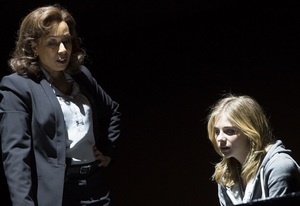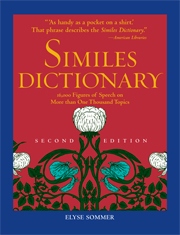Search Curtainup
SITE GUIDE
REVIEWS
REVIEW ARCHIVES
ADVERTISING AT CURTAINUP
FEATURES
NEWS
Broadway
Off-Broadway
NYC Restaurants
BOOKS and CDs
OTHER PLACES
Berkshires
London
California
New Jersey
DC
Philadelphia
Elsewhere
QUOTES
TKTS
PLAYWRIGHTS' ALBUMS
LETTERS TO EDITOR
FILM
LINKS
MISCELLANEOUS
Free Updates
Masthead
A CurtainUp Review
The Library
By Elyse Sommer
|
"We are professional tellers of stories. That's what we do for a living, make up narratives and share them with you our audience. The hope implicit in our telling is is that we somehow reveal something true. We seek to entertain, true, we have to, but we also hope that the entertainment we provide is not just a distraction, but a narrative that opens up the world we live in, exposing it in a deeper and more concentrated way than our normal life affords us." — Oskar Eustis, the Public's Artistic Director in his program notes for The Library. |

Tamara Tunie and Chloë Grace Moretz (Photo credit: Joan Marcus)
|
The Library by Scott Z. Burns arrives at the Newman Theater with all the buzz of another new and noteworthy addition to the Public's winning streak of "best sellers." A world premiere with a timely background, it features not one but three New York stage debuts by big and small screen pros with impressive credentials.
Author Burns has a long resume of original screenplay credits, including Side Effects, The Informant and Contagion. All were directed by Steven Soderbergh who's also the helmer for The Library. Soderbergh's busy directing career began with his Oscar nominated sex, lies, and videotape. Other well-known gigs include Traffic, Erin Brokovich and the Emmy-winning HBO film Candelabra. While he has dipped his toes into live theater in Australia, he is, like Burns, making his New York debut with The Library.
The third and the most impressive debut is by this play's star, the seventeen year old Chloë Grace Moretz, who's been playing leading roles since age five, starting with The Amityville Horror and including cult films like Hit-Girl and Kick Ass. Moretz is onstage even before the play begins which is why the audience is admitted to the theater just fifteen minutes before the action begins. As any experienced actor can tell you, it's not easy to be on stage, silent and immobile as people are still chatting and getting settled in their seats.
Once released from that awkward, comatose set-up, Moretz rises from what turns out to be a hospital stretcher and takes up her character's struggle to survive the trauma of being a double victim of a mass school shooting —first as a badly injured survivor, second as a social pariah as a result of false narratives about what took place in that high school. It's a wonderfully nuanced, mature performance.
So what about the play? In an April 9th New York Times feature by Dave Itzkoff, Scott Z. Burns is quoted as viewing The Library as a "continuation" of his and Soderbergh's "previous explorations of events whose hidden truths run deeper than what is seemingly known."
Given the sadly ongoing timeliness of the 1999 shooting at Columbine High School in Littleton, Colorado, Burns has certainly chosen an all too pertinent topic for his first play. Though drawing on Dave Cullen's nonfiction book Columbine as his source, Burns has created a fictionalized story about Valeen Schnurr, one of the survivors whose experiences were detailed in that book. The problem with any writer's creating a work of art by using intimate details about real people involved in a tragic event — especially if they're still alive as Schnurr is— is likely to raise the question about its being exploitative.
Though this was a question that certainly popped into my head as I watched Mr. Burns's faction unfold, Public's Theater artistic director Oscar Eustis sees no such problem with Burns's approach. As he states in his program notes his hope for The Library is that it will not only entertain but reveal new truths. While I found myself unable to find any strikingly revealing new truths or dismiss the exploitation question, Solderberg's dynamic staging and the performances do indeed make for an absorbing ninety minutes — from the time we see the Moretz's immobilized Caitlin being worked over by an unseen doctor and nurse to her final monologue: We were reading Cold Mountain, by Charles Frazier. I was here. I dont know where God was."
Of course, newspaper, magazine book publishers and film makers have explored the hows, whys and after effects of epic horrors like this before — often augmenting understanding and prevention of recurrence, rather than in the interest of fame and profit, as Ed Cullen's book and the play's chief factual source did. While some of what ends up in print or other media is helpful and enlightening, facts also have a way of becoming distorted or untrue.
Since Mr. Burns sees his play as new and original he apparently is not bothered by the sense of joylessness experienced by Mark Obmascik who was part of the Denver Post team that won a Pulitzer for its coverage of the shooting. ("Winning the Pulitzer was hard because there was no joy in this story. We did our jobs while other people had horrible grief").
Unlike the violent video game recreating the shooting that someone put on the market,The Library is not a worst case example of creating art out of the Columbine tragedy. It just is too close to the facts to work as pure or especially revealing fiction.
Actually, a more seasoned man of the theater than Burns, PJ Paparelli, previously conceived a compelling stage drama called Columbinis. This chilling mix of fiction and docu-drama (co-written by Stephen Karam) began as a story set in a fictional high school in American suburbia and then moved the action to Littleton, Colorado in the days leading up to and including the shootings on April 20, 1999. It opened at DC's Roundhouse Theater in 2005, and moved to the New York Theatre Workshop the following year.
But Parapelli's play reflected the realization that telling a story about a very real act of hard to explain violence in which children are killed and leaves an entire community with forever festering wounds obligates that story teller to avoid deepening those wounds with inauthenticity. That's why watching this slickly staged, more entertaining than deeply emotionally engaging new play made me wish that the Public had chosen Parapelli's 2013 update of Columbinus . which included a final act documenting a re-visit to the Columbine survivors.
It's understandable that having a well known screen writer and director make their stage debut on Lafayette street is a coup for the Public. But Burns' attempt to tell a completely original story with only the vaguest ties to specific events is problematic. The dilemma of his central character, Caitlin Gabriel, is obviously derived from the confusion surrounding the conflicting narratives relating to whether an interchange with the Littleton shooter involved a girl who died or another who survived. The dialogue quoted by another surviving student was eventually correctly attributed to the girl who died. However, in The Library, this is the building block on which everything rests.
As Burns' heroine is a double victim, so he's something of a double borrower. As The Library borrows substantially (but, alas, too manipulatively) from actual events, its theme can be seen as borrowing from Rashomon. You know, the famous Japanese film that added the term "Rashomon Effect" to our vocabulary as a reference for contradictory interpretations of the same events by different persons in the process of uncovering truth. None of this is to say that The Library is just a triple celebrity ticket seller.
Lili Taylor is a standout as the play's most complex character, Dawn Sheridan. Taylor wins our sympathy as the devoutly religious mother of an equally devout daughter who was leading some her doomed classmates in prayer when she was gunned down. It's easy to see why she wants a chance to give some meaning to her daughter's abruptly ended life. But Taylor subtly shifts the audience's to revulsion as we watch her full-throttled grab at the opportunity to do so, especially in a scene with a publisher (David L. Townsend) hot to capitalize on the tragedy.
Tamarie Tunie, whose many TV roles include a lengthy stint on Law & Order: Special Victims Unit, brings an authoritative tone and presence to Detective Washburn. However, the time sequence of her interviews with the students asked to revisit the scene of the crime tends to be confusing . This is especially the case pertaining to her interview with Ryan (Daryl Sabara), the boy whose recollection about who said what to the shooter are so critical to Caitlin's quest for understanding.
No complaints about the rest of the seven member cast either, and Soderbergh's staging is certainly dramatic. Riccardo Hernandez's abstract scenic design is essentially a series of tables and chairs.
David Landers lighting creates a film noir aura. The propulsive change of his background lighting seems almost color coded to indicate the intensity of the growing brouhaha about what Caitlin's role in the death of the students hidden in a school library closet (bright red for the replay of the bloody disaster, soft yellow for the lull after the storm, and so on). The lighting also determines whether we see the actors as shadow figures or in bright movie-like close-ups. Very effective, even though it vibrates with noir-ish flare at some loss of a live stage performance's intimacy.
Whatever the strengths and weaknesses of The Library, I left the Newman Theater hoping (alas, probably futilely so), that we've seen the last of real life counterparts to this story.
|
The Library by Scott Z. Burns Directed by Steven Soderbergh Cast: Ben Livingston (Reverend Dunston, ADA Thornton); Chloë Grace Moretz (Caitlin Gabriel); Michael O'Keefe (Nolan Gabriel, Surgeon); Daryl Sabara (Ryan Mayes, Marshall Bauer); Lili Taylor (Dawn Sheridan); David Townsend (Publisher, Agent Murtaugh); Tamara Tunie (Detective Gwen Washburn); and Jennifer Westfeldt (Elizabeth Gabriel, Nurse) Scenic design by Riccardo Hernandez Costume design by Gabriel Berry Lighting design by David Lander Sound design by Darron L West and M.Florian Staab Voice coach: Andrew Wade Stage Manager: Samantha Fremer Running time: 100 minutes, no intermission Public Theater/The Newman (212) 967-7555, www.publictheater.org From 3/25/14; opening 4/15/14; closing 4/27/14 . Single tickets, starting at $75 Tuesday through Sunday at 7:30 p.m., and Saturday and Sunday at 2:00 p.m. Reviewed by Elyse Sommer at April11th Press preview |
|
REVIEW FEEDBACK Highlight one of the responses below and click "copy" or"CTRL+C"
Paste the highlighted text into the subject line (CTRL+ V): Feel free to add detailed comments in the body of the email. . .also the names and emails of any friends to whom you'd like us to forward a copy of this review. For a feed to reviews and features as they are posted add http://curtainupnewlinks.blogspot.com to your reader Curtainup at Facebook . . . Curtainup at Twitter Subscribe to our FREE email updates: E-mail: esommer@curtainup.comesommer@curtainup.com put SUBSCRIBE CURTAINUP EMAIL UPDATE in the subject line and your full name and email address in the body of the message. If you can spare a minute, tell us how you came to CurtainUp and from what part of the country. |

|


 Book of Mormon -CD
Book of Mormon -CD